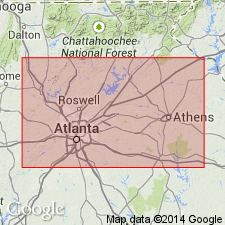
- Usage in publication:
-
- Crawfish Schist*
- Modifications:
-
- Named
- Dominant lithology:
-
- Schist
- AAPG geologic province:
-
- Piedmont-Blue Ridge province
Summary:
Named as a formation in Allatoona Complex. Named for Crawfish Creek in Villa Rica 7.5-min quad, northwestern GA, where it is sporadically exposed in the creek and along hillsides above creek. Type section is along an unnamed creek that flows east from unnamed lake about 4 km south of I-20 past abandoned Villa Rica waterworks in Villa Rica quad. Consists of garnet-bearing schist containing numerous quartz stringers and lenses and mappable "clean" quartzite. At either kyanite or sillimanite grade everywhere. Underlies graphitic Frolona Formation in Crawfish Creek structure (where no basement has been found). In Mulberry Rock structure, it is in contact with basement Corbin Metagranite (revised). Age is Early(?) to Middle Proterozoic based on isotopically dated Middle(?) to Proterozoic Corbin Metagranite intruding it, and because of metamorphic grade differences. Report includes geologic map and correlation chart.
Source: GNU records (USGS DDS-6; Reston GNULEX).
For more information, please contact Nancy Stamm, Geologic Names Committee Secretary.
Asterisk (*) indicates usage by the U.S. Geological Survey. Other usages by state geological surveys.
"No current usage" (†) implies that a name has been abandoned or has fallen into disuse. Former usage and, if known, replacement name given in parentheses ( ).
Slash (/) indicates name does not conform with nomenclatural guidelines (CSN, 1933; ACSN, 1961, 1970; NACSN, 1983, 2005). This may be explained within brackets ([ ]).

